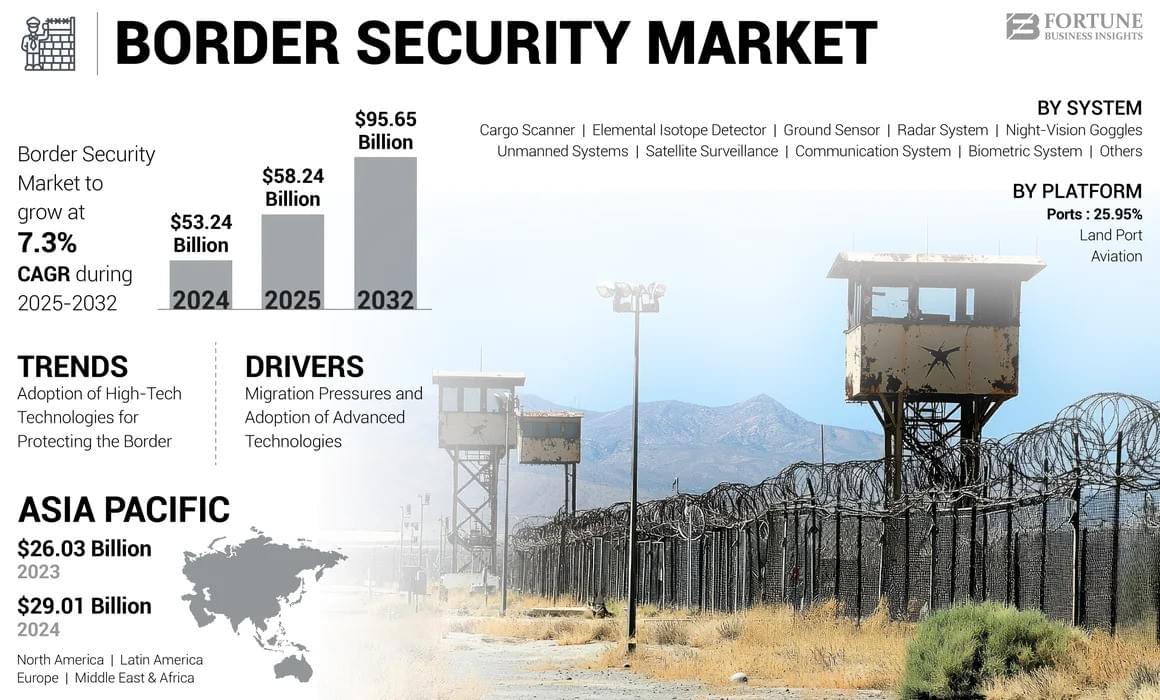The global border security market is entering a critical growth phase as governments worldwide step up investments in advanced surveillance and protection technologies. According to Fortune Business Insights™, the market was valued at USD 53.24 billion in 2024 and is projected to rise from USD 58.24 billion in 2025 to USD 95.65 billion by 2032, reflecting a CAGR of 7.3% during the forecast period.
The expansion is largely driven by geopolitical tensions, cross-border conflicts, illegal migrations, and growing threats of terrorism and trafficking. Countries are turning to modern solutions—including AI-powered drones, biometric systems, advanced radar, and satellite surveillance—to secure perimeters more effectively.

Key Market Players
Some of the leading companies shaping the border security industry include:
- Northrop Grumman Corporation (U.S.)
- Airbus SE (U.S.)
- Raytheon Technologies Corporation (U.S.)
- Elbit Systems Ltd. (Israel)
- Thales Group (France)
- BAE Systems plc (U.K.)
- Israel Aerospace Industries Ltd. (IAI) (Israel)
- Leonardo SpA. (Italy)
- Rafael Advanced Defense Systems Ltd. (France)
- Teledyne FLIR LLC (U.S.)
These firms focus on contracts, partnerships, and R&D to deliver next-generation border security systems.
Information Source:
https://www.fortunebusinessinsights.com/border-security-system-market-105208
Market Segmentation
By system, radar systems remain the dominant segment owing to their critical role in wide-area monitoring, perimeter surveillance, and counter-drone operations. With growing cross-border threats, illegal infiltration, and the rising use of unmanned aerial vehicles (UAVs), militaries and security agencies are increasingly deploying advanced radar technologies capable of long-range detection and real-time tracking. Biometric systems, on the other hand, are projected to witness the fastest growth during the forecast period. The need for secure, automated identity verification at border checkpoints is fueling demand for facial recognition, iris scanning, and multi-factor authentication tools, making them central to next-generation border security frameworks. Other systems, including cargo scanners, isotope detectors, ground sensors, unmanned systems, night-vision goggles, satellite surveillance, and communication solutions, are also gaining traction as part of integrated security infrastructures. These technologies complement radar and biometrics by ensuring layered security and improved situational awareness across diverse terrains.
From a platform perspective, land ports account for the largest market share, supported by the deployment of advanced radar arrays, surveillance towers, and vehicle inspection systems. These technologies are essential in detecting illegal crossings, smuggling activities, and unauthorized trade, especially in regions with vast land borders. Maritime ports are emerging as another critical area of investment, as global trade growth and heightened risks of trafficking, piracy, and illegal shipping necessitate modernized naval security systems, advanced scanning equipment, and perimeter monitoring solutions. The aviation sector is expected to experience the fastest growth among platforms, driven by surging passenger volumes and the adoption of biometric-based screening systems. Airports worldwide are investing heavily in AI-driven passenger management, automated border control kiosks, and advanced baggage inspection systems, making aviation a central hub for the implementation of next-generation border security solutions.
Regional Insights
Asia Pacific – The dominant region with 53.48% market share in 2024, fueled by rising defense budgets, border disputes, and large-scale illegal migration challenges in India, China, and South Korea.
Europe – Expected to be the fastest-growing region, with the Russia-Ukraine war spurring higher investments in AI-driven drones, biometric checkpoints, and surveillance systems.
North America – Strong growth led by U.S. initiatives such as DHS contracts for autonomous surveillance towers and smart cargo-tracking technologies.
Middle East & Africa – Increasing demand for security systems due to regional conflicts and cross-border crime.
Latin America – Modernization of port and land borders driving regional expansion.
Market Drivers
- Increasing Migration Pressures – UNHCR reported 130 million forcibly displaced people in 2024, driving governments to upgrade legacy systems with AI and biometrics.
- Adoption of High-Tech Systems – Drones, radar, surveillance towers, and biometric authentication are becoming essential for perimeter and checkpoint security.
- Government Funding – EU allocated USD 2.4 billion in 2024 for its Secure Borders Initiative, while the U.S. DHS signed a USD 450 million contract with Anduril for autonomous towers.
Market Restraints
The high financial burden of integrating advanced EO/IR (Electro-Optical/Infrared) systems with legacy military platforms poses challenges. Costs tied to hardware upgrades, testing, and personnel training can slow adoption.
Key Trends
- Shift toward AI-driven drones and biometric authentication at borders.
- Integrated cross-border solutions where countries collaborate to fight trafficking and terrorism.
- Standardization of systems across regions, reducing costs and boosting adoption.
- Expansion of satellite-enabled surveillance networks for wide-area monitoring.
Opportunities Ahead
- Joint security initiatives like the EU-Africa Sahel Shield (USD 1.8 billion) for drones and biometrics.
- Private sector investments in digital border management technologies.
- Interoperable systems that streamline trade while strengthening national defense.
Recent Developments
March 2025 – U.S. Customs and Border Protection (CBP) awarded the initial border wall construction contract to Granite Construction Co. valued at USD 70.29 million. The project covers the development of approximately seven miles of new wall in Hidalgo County, Texas, located within the Rio Grande Valley (RGV) Sector of the U.S. Border Patrol (USBP). Once completed, the wall is expected to strengthen the Department of Homeland Security (DHS) by improving its ability to deter and prevent illegal crossings, as well as disrupt drug- and human-trafficking activities carried out by cartels in the region.
No responses yet